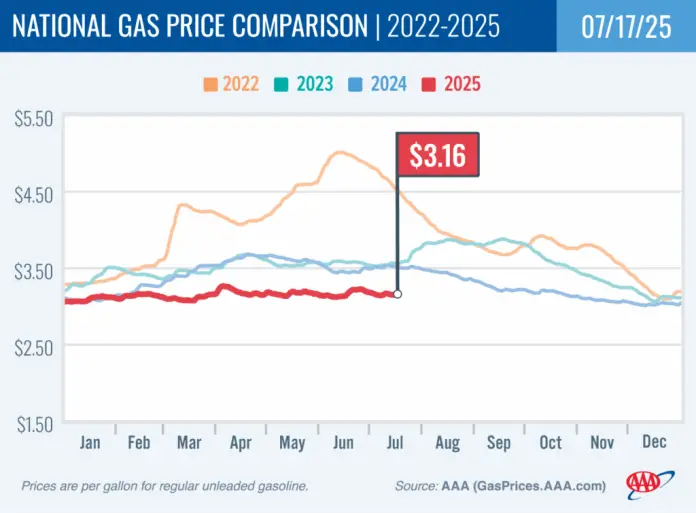In a surprising turn for summer drivers, gas prices have dipped to refreshing lows with the national average for a gallon of regular fuel settling at $3.16, just a penny lower than last week. This drop in prices mirrors the summer of 2021, offering a small but welcome respite for consumers and small business owners alike.
This latest data, released by the American Automobile Association (AAA), highlights how fluctuating gas prices can impact the operational costs of small businesses, particularly those reliant on transportation and delivery services. The average price decrease could help ease financial pressure for businesses managing logistics, customer deliveries, and expenses related to employee commuting.
The slight dip follows a trend observed over the past month, where prices hovered around $3.17. A year ago, the average price was significantly higher at $3.51, showcasing a substantial reduction this season—by approximately 12%. For businesses operating in areas where gas prices align closely with local economic conditions, this change could bolster cash flow and buoy consumer spending.
Gas demand also appears to wane slightly. According to recent data from the Energy Information Administration (EIA), gasoline demand decreased to 8.48 million barrels per day, down from 9.15 million the prior week. While this decline may point to decreased consumer travel, it also reflects emerging shifts in business operations, where potential remote work situations can lessen fuel expenditure.
While overall supply increased—from 229.5 million barrels to 232.9 million—gasoline production saw a decline, averaging 9.1 million barrels per day. For small business owners, maintaining awareness of these fluctuations in supply chains is critical. Analyzing operational strategies in light of these shifts can provide an edge in cost management.
Oil market dynamics continue to play a role in shaping fuel pricing. Crude oil prices have settled at $66.38 per barrel, after a slight decrease of 14 cents from the previous close. Notably, U.S. crude oil inventories remain approximately 8% below average for this time of year, suggesting that continued monitoring of crude oil prices could be essential for businesses planning their budgets in the months ahead.
As summer progresses, the potential for tropical storms and low-pressure systems in the Gulf Coast remains a variable worth noting. While the latest forecast indicates a low likelihood of storms developing, small business owners in coastal areas should remain prepared for sudden disruptions that could arise from unexpected weather events, such as refinery damage or flooding. Preparing for these challenges can help mitigate risks associated with supply chain interruptions.
For those considering electric vehicles or electric charging options, the national average cost per kilowatt-hour at public EV charging stations has remained static at 36 cents. Business owners investing in electric fleets may find this information advantageous for budgeting and strategizing for long-term sustainability. Additionally, operators in states where public charging costs are comparatively lower could benefit from increased profits, as the operational costs of electric vehicles are often less volatile than their gasoline counterparts.
Speaking of regional variations, gas prices across the nation reflect stark differences. For instance, California leads the charge with an average price of $4.50 per gallon, while Mississippi enjoys prices as low as $2.72. Understanding these fluctuations regionally can guide small business owners in making informed decisions about fleet operations, retail pricing, and localized marketing strategies.
Small business owners should also be aware of the broader implications of these gas price shifts on consumer behavior. The impact of lower fuel costs can lead to increased disposable income, allowing consumers to reinvest in local businesses, which can further stimulate economic activity.
For additional insights regarding gas and electric charging prices, check out the AAA TripTik Travel Planner at AAA TripTik Travel Planner. Keeping an adaptable mindset toward fluctuating gas prices and being proactive about operational adjustments can position small businesses to thrive despite the ongoing economic uncertainties.
For more detailed information, you can read the full press release here.
Image Via Gas Price



